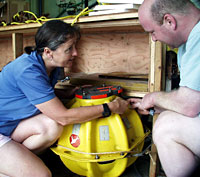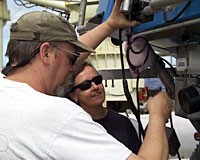|
|
Interviews: Marine Geochemist Susan
Humphris
Susan Humphris is a marine geochemist who studies the geology and chemical composition of mid-ocean ridges. During this expedition, Susan and her colleague Dan Fornari will help to locate and map hydrothermal vents.
Academics didn’t stop there. She earned a PhD in Chemical Oceanography from the MIT -Woods Hole Oceanographic Joint Program, and then completed a Postdoctoral Fellowship at Imperial College in London. She married an American and returned to the United States to teach oceanography to college students with the Sea Education Association. Her office for the next 13 years was two large sailing research vessels. On board, students learned how to operate the ship, cook a meal at sea, and perform science experiments. It also gave Susan many hours doing what she loved; spending time on the water. She’s also spent a lot of time under the water. Susan says diving with Alvin is one of the highlights of her career. She was 34-years-old and “very excited” when, in 1985, she climbed aboard the submersible and headed down into the dark, cold Atlantic Ocean. While Susan has been on over 25 dives since then, she takes pride in her initial dives. During that cruise, she and other scientists on the RV Atlantis II discovered hydrothermal vents in the Atlantic Ocean. Not only did this show that organisms at vents in the Atlantic Ocean are different from those in the Pacific Ocean, but the site also proved to be one of the largest mineral deposits yet found in the ocean. “I like the feeling of exploring and discovering, of seeing something no one else has seen,” she says. It’s also a big responsibility. “Since you may be the only person that sees something, you have to be the one to describe it the best that you can,” she says. Colleagues refer to her as level-headed, a top-notch scientist with great organizational skills and a warm sense of humor. “She is someone who truly loves the ocean,” says her colleague of 28 years, Dan Fornari. “You can tell from her descriptions of sea life on the ship and at Woods Hole.” Her eye for details helps on the job. When scientists dive in Alvin, they take along a tape recorder to verbally note the things they see out the porthole. Often they become so excited by what they see that when they return to the surface and listen to the tape, all they hear is “Wow! Look at that!” So on that first dive, Susan reminded herself that she would need to focus on talking into the recorder. After a glimpse at black smoker chimneys and millions of white shrimp, “my first reaction was to shout ’wow’! But then I remembered that I had to say the time and describe where we were and what we were seeing.” Not every moment in the life of a marine geochemist is as thrilling as a dive in Alvin. Crushing and powdering rock samples for analysis, “is a long, dull process, after about 100 rocks.” In fact, “it’s dull after two rocks.” But she’s glad for the life she’s chosen. Today she lives with her marine geologist husband Pat Lohmann, a cat named Pussli and lots of chickens in Massachusetts, three miles from the Woods Hole Oceanographic Institution. Even at home and off research vessels, she’s never far from the sea.
|
|||
Mailing List | Feedback | Glossary | For Teachers | About Us | Contact
© 2010 Dive and Discover™. Dive and Discover™ is a registered trademark of
Woods
Hole Oceanographic Institution
 Marine geochemist Susan Humphris wears many hats on this research expedition. She dredges rocks, makes maps of the hydrothermal vent sites, organizes meetings -- and she answers most of YOUR email questions on the Dive and Discover website. Here she checks out the transponders for navigating the vehicles with biologist Tim Shank.
Marine geochemist Susan Humphris wears many hats on this research expedition. She dredges rocks, makes maps of the hydrothermal vent sites, organizes meetings -- and she answers most of YOUR email questions on the Dive and Discover website. Here she checks out the transponders for navigating the vehicles with biologist Tim Shank. 